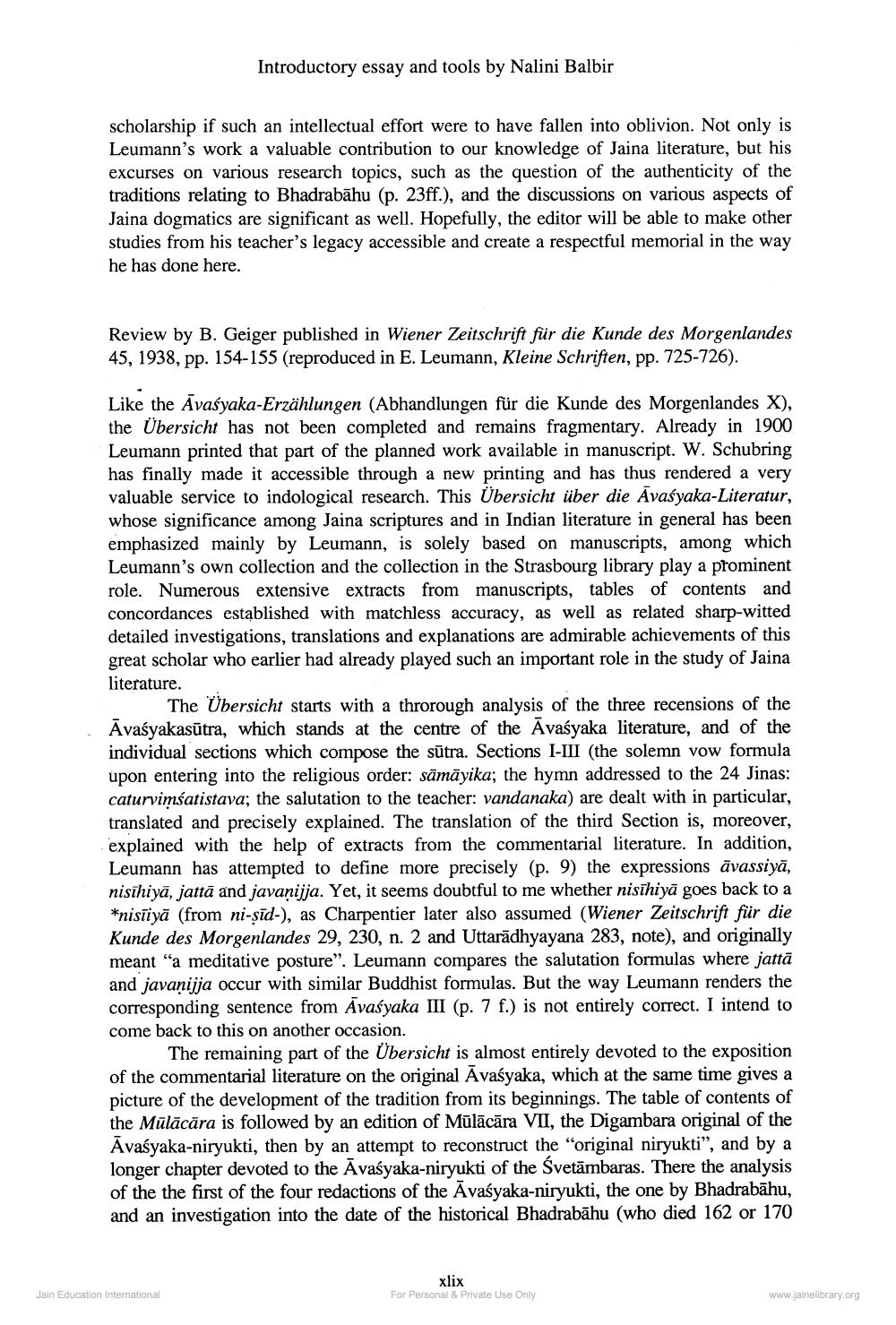________________
Introductory essay and tools by Nalini Balbir
scholarship if such an intellectual effort were to have fallen into oblivion. Not only is Leumann's work a valuable contribution to our knowledge of Jaina literature, but his excurses on various research topics, such as the question of the authenticity of the traditions relating to Bhadrabāhu (p. 23ff.), and the discussions on various aspects of Jaina dogmatics are significant as well. Hopefully, the editor will be able to make other studies from his teacher's legacy accessible and create a respectful memorial in the way he has done here.
Review by B. Geiger published in Wiener Zeitschrift für die Kunde des Morgenlandes 45, 1938, pp. 154-155 (reproduced in E. Leumann, Kleine Schriften, pp. 725-726).
Like the Āvaśyaka-Erzählungen (Abhandlungen für die Kunde des Morgenlandes X), the Übersicht has not been completed and remains fragmentary. Already in 1900 Leumann printed that part of the planned work available in manuscript. W. Schubring has finally made it accessible through a new printing and has thus rendered a very valuable service to indological research. This Übersicht über die Avasyaka-Literatur, whose significance among Jaina scriptures and in Indian literature in general has been emphasized mainly by Leumann, is solely based on manuscripts, among which Leumann's own collection and the collection in the Strasbourg library play a prominent role. Numerous extensive extracts from manuscripts, tables of contents and concordances established with matchless accuracy, as well as related sharp-witted detailed investigations, translations and explanations are admirable achievements of this great scholar who earlier had already played such an important role in the study of Jaina literature.
The Übersicht starts with a throrough analysis of the three recensions of the Avaśyakasūtra, which stands at the centre of the Avaśyaka literature, and of the individual sections which compose the sūtra. Sections I-III (the solemn vow formula upon entering into the religious order: sāmāyika; the hymn addressed to the 24 Jinas: caturvimśatistava; the salutation to the teacher: vandanaka) are dealt with in particular, translated and precisely explained. The translation of the third Section is, moreover, explained with the help of extracts from the commentarial literature. In addition, Leumann has attempted to define more precisely (p. 9) the expressions āvassiyā, nisīhiyā, jattā and javanijja. Yet, it seems doubtful to me whether nisīhiyā goes back to a *nisīiyā (from ni-șīd-), as Charpentier later also assumed (Wiener Zeitschrift für die Kunde des Morgenlandes 29, 230, n. 2 and Uttarādhyayana 283, note), and originally meant "a meditative posture". Leumann compares the salutation formulas where jattā and javanijja occur with similar Buddhist formulas. But the way Leumann renders the corresponding sentence from Avasyaka III (p. 7 f.) is not entirely correct. I intend to come back to this on another occasion.
The remaining part of the Übersicht is almost entirely devoted to the exposition of the commentarial literature on the original Āvaśyaka, which at the same time gives a picture of the development of the tradition from its beginnings. The table of contents of the Mülācāra is followed by an edition of Mūlācāra VII, the Digambara original of the Avaśyaka-niryukti, then by an attempt to reconstruct the "original niryukti", and by a longer chapter devoted to the Āvaśyaka-niryukti of the Svetāmbaras. There the analysis of the the first of the four redactions of the Āvasyaka-niryukti, the one by Bhadrabāhu, and an investigation into the date of the historical Bhadrabāhu (who died 162 or 170
xlix For Personal & Private Use Only
Jain Education International
www.jainelibrary.org




